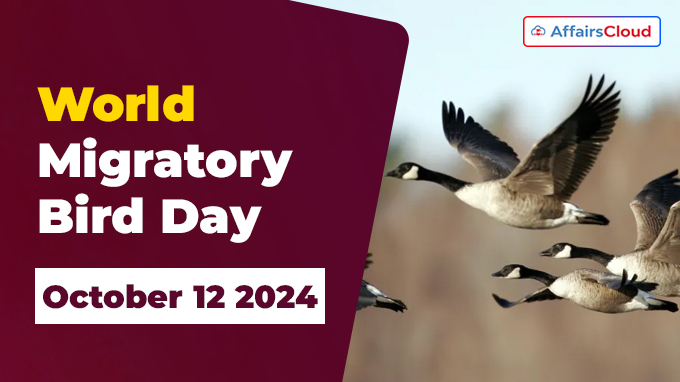
The United Nations (UN)’s World Migratory Bird Day (WMBD) is biannually observed across the globe on the 2nd Saturday of May and October, to raise awareness of migratory birds and the need for international cooperation to conserve them.
The WMBD 2024 falls on 11th May 2024 and 12th October 2024.
- WMBD 2023 was observed on 13th May 2023 and 14th October 2023 and WMBD 2025 will be observed on 10th May 2025 and 11th October 2025.
Theme:
The theme/campaign slogan of WMBD 2024 is “Protect Insects, Protect Birds”.
i.The WMBD 2024 focuses on insects and their importance to migratory birds.
ii.The theme highlights the important role insects play in supporting bird populations. Many birds rely on insects for food, especially during breeding and migration.
Background:
i.International Migratory Bird Day (IMBD), now WMBD, was created in the USA in 1993 by visionaries at the Smithsonian Migratory Bird Center.
ii.It was organised by a collaborative partnership among 2 UN treaties –the Convention on Migratory Species (CMS); the African-Eurasian Migratory Waterbird Agreement (AEWA), and Environment for the Americas (EFTA).
iii.On the occasion of its 10th anniversary in 2005, the AEWA Secretariat initiated the Migratory Waterbird Days (MWD) which were held in Africa, Europe, and parts of Asia.
iv.The 1st ever WMBD was launched by AEWA and CMS on the weekend of 8-9 April 2006 on Kuki Gallmann’s famous wildlife reserve ‘Ole Ari Nyiro’ in Laikipia, Kenya.
v.In 2023, the East Asian-Australasian Flyway Partnership (EAAFP) was added to this Partnership to strengthen engagement and awareness for migratory birds in the East Asian-Australasian Flyway.
Why May and October?
I.WMBD annually celebrated on the 2nd Saturday in May and October aligns with the cyclic nature of bird migration in different hemispheres.
ii.2nd Saturday of May is celebrated in Canada and the United States of America (USA) and the 2nd Saturday of October is celebrated in Mexico, Central and South America, and the Caribbean.
Key Points:
i.An analysis in the journal Science revealed an alarming decline of approximately 9% in the global insect population per decade.
ii.The USA and Canada have witnessed a 29% drop in bird populations since 1970, equating to around 2.9 billion fewer birds.




